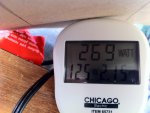ATSman
ATSman
- Location
- San Francisco Bay Area
- Occupation
- Electrical Engineer/ Electrical Testing & Controls Retired 2025
I purchased a 600W grid tie inverter about 2 wks ago and connected
(2) 240W solar panels to it. After doing some testing & measuring the output of the panels separately I measure 32VDC open circuit and around 8 amps short circuit current(256W.) With both panels connected in parallel at inverter input I am only getting around 270W max AC output mid day when sun is at optimum angle. With inverter effeciency stated as 85% I calculate I should be getting around 408W max output. If I connect only 1 panel to inverter the max output is around 170W. Multiply Times 2 panels should be 340W. I measure the current from 1 panel with both in parallel to inverter and read 4A DC. It seems the output current drops to half of panel rating when connected in parallel with inverter. Can you explain why and what I can do to get more power out? Is this because of the impedance power matching between the panel output and the inverter input?
Would connecting each panel to a separate 300W inverter be a better way for me to get the most out of the panels?
I can supply the panel and inverter specs if required.
(2) 240W solar panels to it. After doing some testing & measuring the output of the panels separately I measure 32VDC open circuit and around 8 amps short circuit current(256W.) With both panels connected in parallel at inverter input I am only getting around 270W max AC output mid day when sun is at optimum angle. With inverter effeciency stated as 85% I calculate I should be getting around 408W max output. If I connect only 1 panel to inverter the max output is around 170W. Multiply Times 2 panels should be 340W. I measure the current from 1 panel with both in parallel to inverter and read 4A DC. It seems the output current drops to half of panel rating when connected in parallel with inverter. Can you explain why and what I can do to get more power out? Is this because of the impedance power matching between the panel output and the inverter input?
Would connecting each panel to a separate 300W inverter be a better way for me to get the most out of the panels?
I can supply the panel and inverter specs if required.


